

Compact Muon Solenoid
LHC, CERN
| CMS-PAS-BPH-21-002 | ||
| Angular analysis of the B0→K∗0(892)μ+μ− decay at √s= 13 TeV | ||
| CMS Collaboration | ||
| 4 June 2024 | ||
| Abstract: The full set of optimised CP-averaged observables is measured in the angular analysis of the decay B0→K∗0(892)μ+μ− using a sample of proton-proton collisions at √s= 13 TeV collected with the CMS detector at the LHC, corresponding to an integrated luminosity of 140 fb−1. The analysis is performed in bins of the invariant mass squared of the dimuon system. These results are among the most precise experimental measurements of the angular observables of the B0→K∗0(892)μ+μ− decay. | ||
|
Links:
CDS record (PDF) ;
Physics Briefing ;
CADI line (restricted) ;
These preliminary results are superseded in this paper, Submitted to PLB. The superseded preliminary plots can be found here. |
||
| Figures & Tables | Summary | Additional Figures & Tables | References | CMS Publications |
|---|
| Figures | |
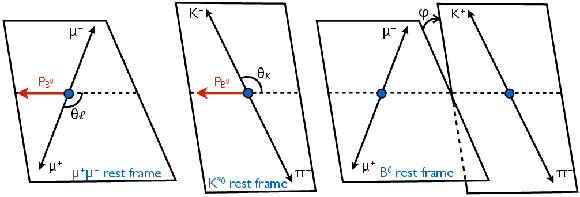
png pdf |
Figure 1:
Sketch representing the definition of the angular variables cosθl (left), cosθK (centre), and ϕ (right). |
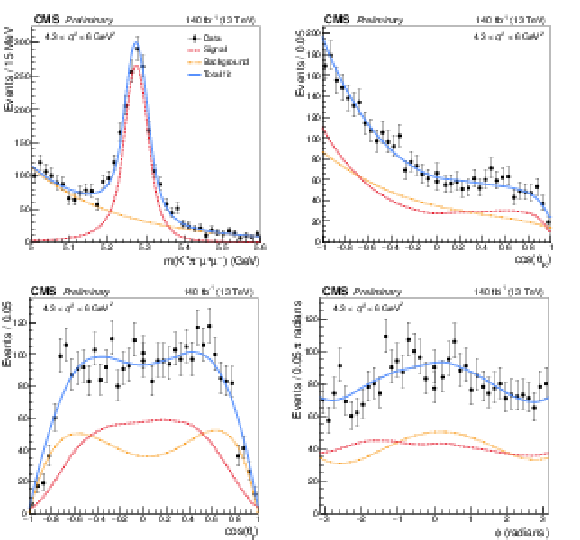
png pdf |
Figure 2:
Mass and angular distributions for 4.3 <q2< 6 GeV2. The projections of the total fitted distribution (in blue) and its different components are overlaid. The signal is shown by the red dashed line, and the background by the orange line. |
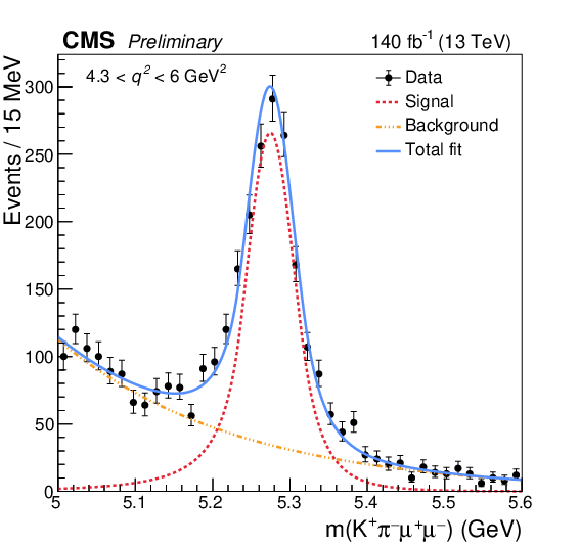
png pdf |
Figure 2-a:
Mass and angular distributions for 4.3 <q2< 6 GeV2. The projections of the total fitted distribution (in blue) and its different components are overlaid. The signal is shown by the red dashed line, and the background by the orange line. |
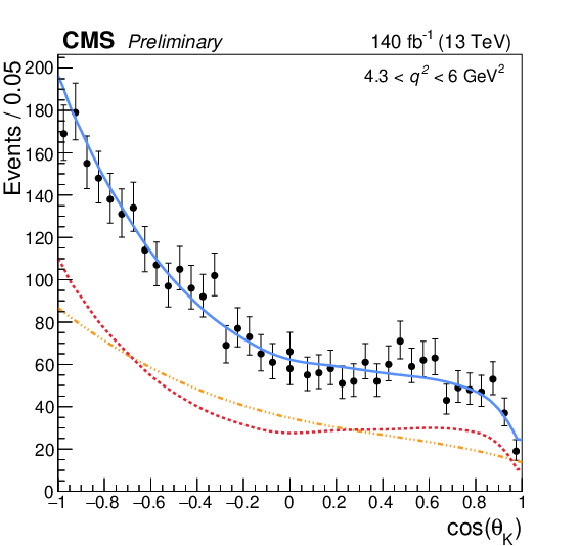
png pdf |
Figure 2-b:
Mass and angular distributions for 4.3 <q2< 6 GeV2. The projections of the total fitted distribution (in blue) and its different components are overlaid. The signal is shown by the red dashed line, and the background by the orange line. |
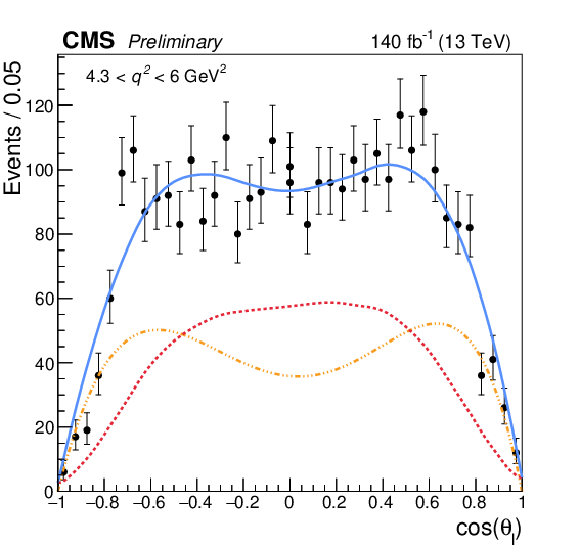
png pdf |
Figure 2-c:
Mass and angular distributions for 4.3 <q2< 6 GeV2. The projections of the total fitted distribution (in blue) and its different components are overlaid. The signal is shown by the red dashed line, and the background by the orange line. |
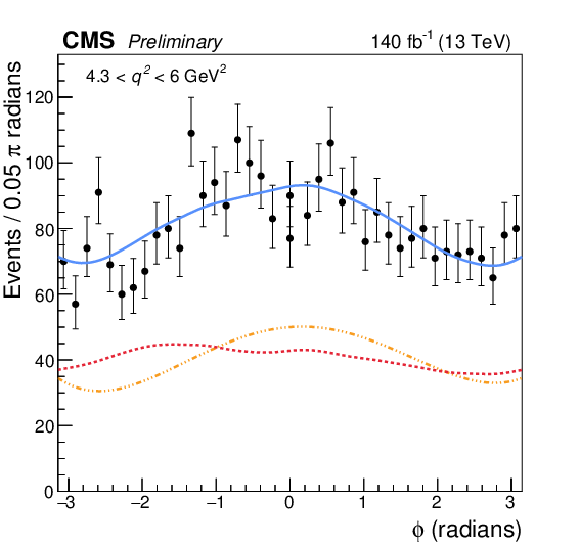
png pdf |
Figure 2-d:
Mass and angular distributions for 4.3 <q2< 6 GeV2. The projections of the total fitted distribution (in blue) and its different components are overlaid. The signal is shown by the red dashed line, and the background by the orange line. |
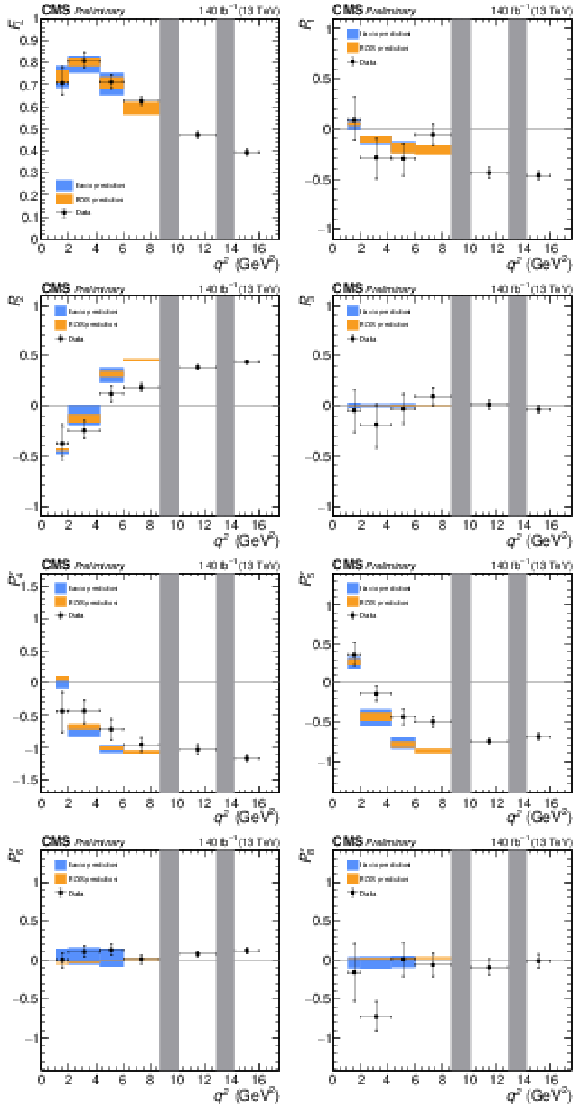
png pdf |
Figure 3:
Measurements of the angular parameters versus q2. The inner vertical bars represent the statistical uncertainties, while the outer vertical bars give the total uncertainties. The horizontal bars show the bin widths. The vertical shaded regions correspond to the J/ψ and ψ(2S) resonances. The data are compared to two sets of predictions based on flavio [33] and EOS [34] libraries, averaged in each bin. |
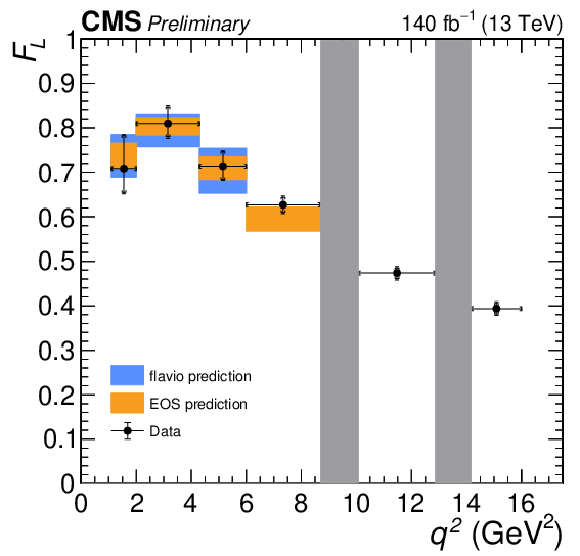
png pdf |
Figure 3-a:
Measurements of the angular parameters versus q2. The inner vertical bars represent the statistical uncertainties, while the outer vertical bars give the total uncertainties. The horizontal bars show the bin widths. The vertical shaded regions correspond to the J/ψ and ψ(2S) resonances. The data are compared to two sets of predictions based on flavio [33] and EOS [34] libraries, averaged in each bin. |
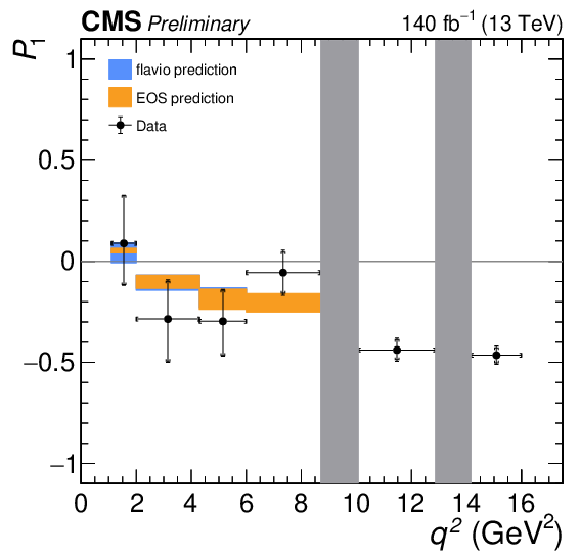
png pdf |
Figure 3-b:
Measurements of the angular parameters versus q2. The inner vertical bars represent the statistical uncertainties, while the outer vertical bars give the total uncertainties. The horizontal bars show the bin widths. The vertical shaded regions correspond to the J/ψ and ψ(2S) resonances. The data are compared to two sets of predictions based on flavio [33] and EOS [34] libraries, averaged in each bin. |
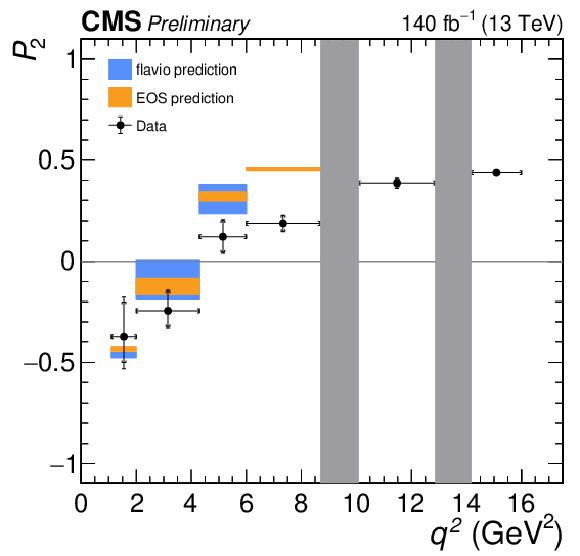
png pdf |
Figure 3-c:
Measurements of the angular parameters versus q2. The inner vertical bars represent the statistical uncertainties, while the outer vertical bars give the total uncertainties. The horizontal bars show the bin widths. The vertical shaded regions correspond to the J/ψ and ψ(2S) resonances. The data are compared to two sets of predictions based on flavio [33] and EOS [34] libraries, averaged in each bin. |
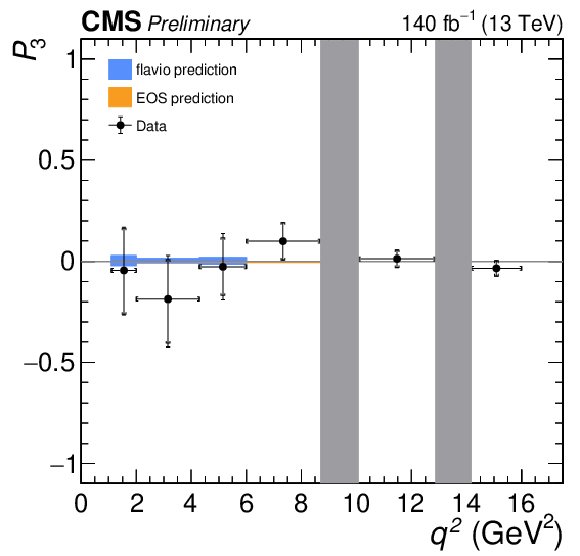
png pdf |
Figure 3-d:
Measurements of the angular parameters versus q2. The inner vertical bars represent the statistical uncertainties, while the outer vertical bars give the total uncertainties. The horizontal bars show the bin widths. The vertical shaded regions correspond to the J/ψ and ψ(2S) resonances. The data are compared to two sets of predictions based on flavio [33] and EOS [34] libraries, averaged in each bin. |
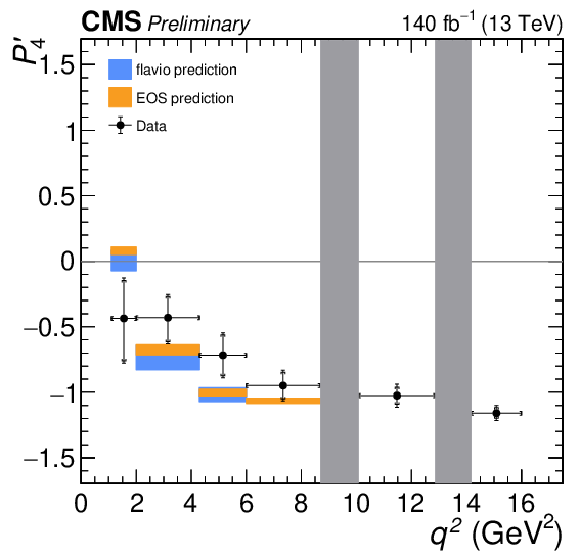
png pdf |
Figure 3-e:
Measurements of the angular parameters versus q2. The inner vertical bars represent the statistical uncertainties, while the outer vertical bars give the total uncertainties. The horizontal bars show the bin widths. The vertical shaded regions correspond to the J/ψ and ψ(2S) resonances. The data are compared to two sets of predictions based on flavio [33] and EOS [34] libraries, averaged in each bin. |
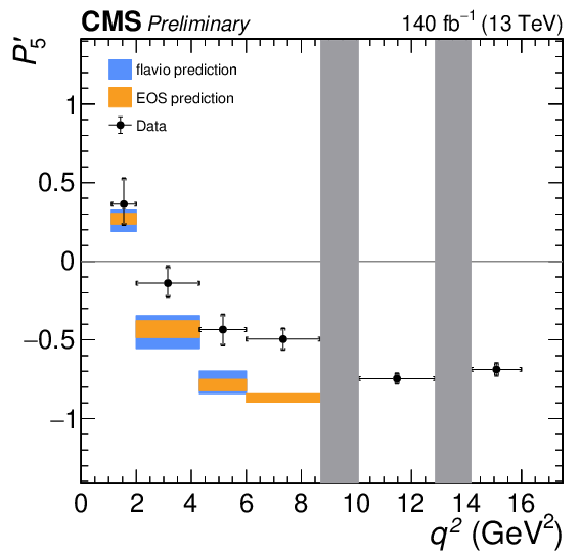
png pdf |
Figure 3-f:
Measurements of the angular parameters versus q2. The inner vertical bars represent the statistical uncertainties, while the outer vertical bars give the total uncertainties. The horizontal bars show the bin widths. The vertical shaded regions correspond to the J/ψ and ψ(2S) resonances. The data are compared to two sets of predictions based on flavio [33] and EOS [34] libraries, averaged in each bin. |
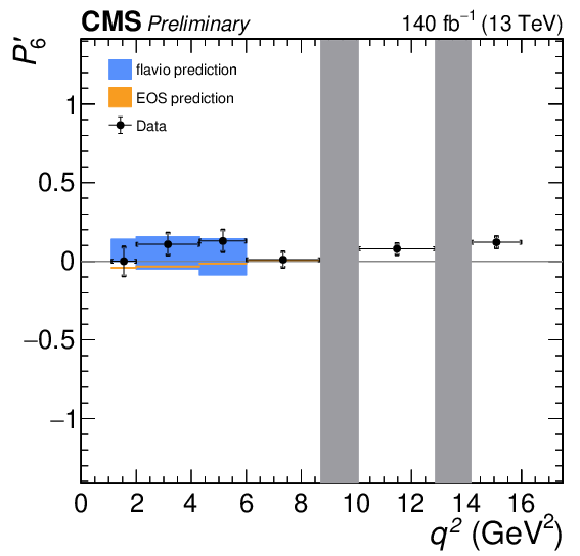
png pdf |
Figure 3-g:
Measurements of the angular parameters versus q2. The inner vertical bars represent the statistical uncertainties, while the outer vertical bars give the total uncertainties. The horizontal bars show the bin widths. The vertical shaded regions correspond to the J/ψ and ψ(2S) resonances. The data are compared to two sets of predictions based on flavio [33] and EOS [34] libraries, averaged in each bin. |
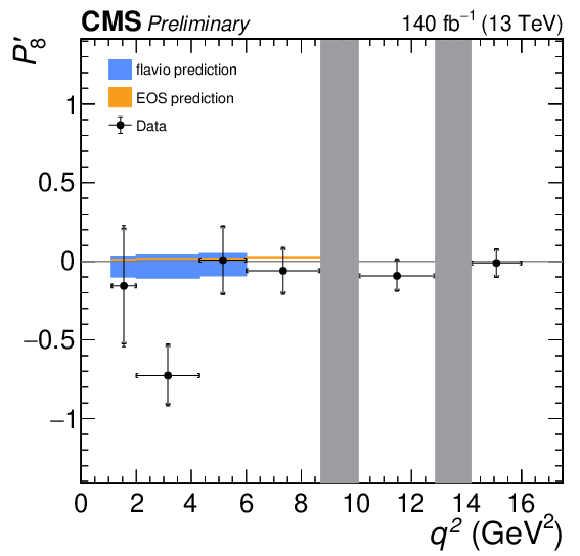
png pdf |
Figure 3-h:
Measurements of the angular parameters versus q2. The inner vertical bars represent the statistical uncertainties, while the outer vertical bars give the total uncertainties. The horizontal bars show the bin widths. The vertical shaded regions correspond to the J/ψ and ψ(2S) resonances. The data are compared to two sets of predictions based on flavio [33] and EOS [34] libraries, averaged in each bin. |
| Tables | |

png pdf |
Table 1:
Systematic uncertainties on the various angular parameters. For each source of uncertainty, the range covers the variation observed across the q2 bins. |

png pdf |
Table 2:
Measured CP-averaged angular observables, in the corresponding q2 bins. The first uncertainties are statistical and the second systematic. |
| Summary |
| In summary, the study of the full angular distribution of the B0→K∗0μ+μ− decay has been performed on 140 fb−1 of proton-proton collision data recorded by the CMS detector at the LHC at center-of-mass energy of 13 TeV. The complete set of CP-averaged observables has been measured via unbinned maximum-likelihood fits to the signal mass and angular distributions, in bins of q2 ranging from 1.1 to 16 GeV2. These results are among the most precise experimental measurements of the angular observables of the B0→K∗0μ+μ− decay. |
| Additional Figures | |
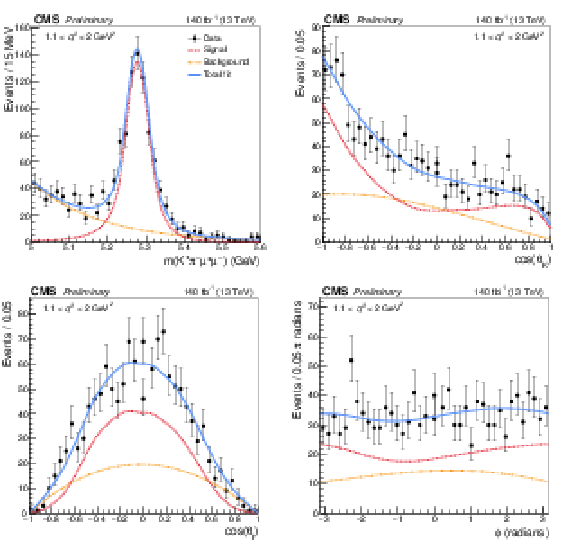
png pdf |
Additional Figure 1:
Mass and angular distributions for 1.1 <q2< 2 GeV2. The projections of the total fitted distribution (in blue) and its different components are overlaid. The signal is shown by the red dashed line, and the background by the orange line. |
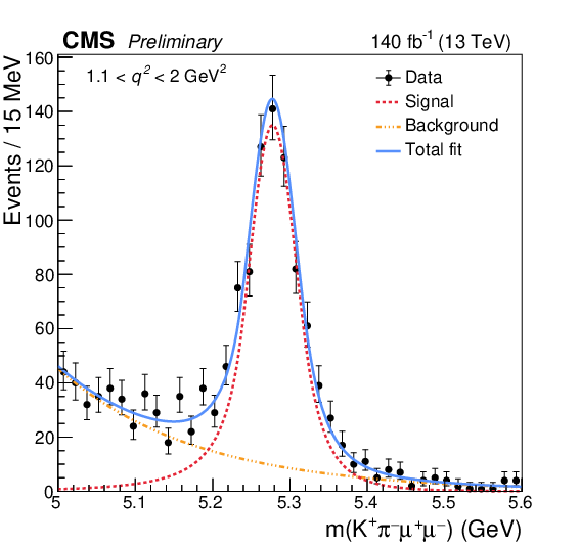
png pdf |
Additional Figure 1-a:
Mass and angular distributions for 1.1 <q2< 2 GeV2. The projections of the total fitted distribution (in blue) and its different components are overlaid. The signal is shown by the red dashed line, and the background by the orange line. |
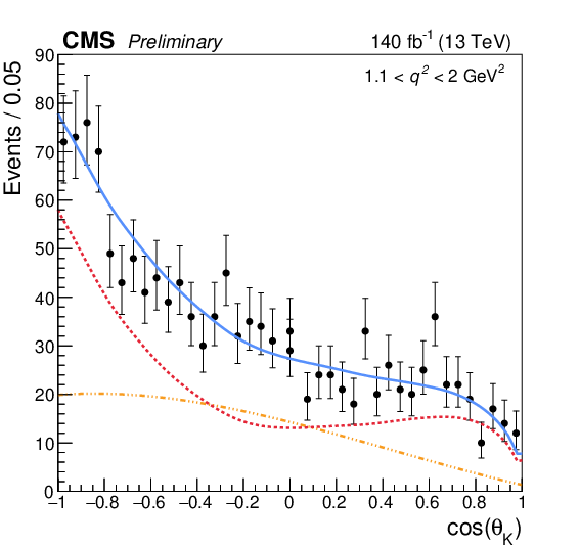
png pdf |
Additional Figure 1-b:
Mass and angular distributions for 1.1 <q2< 2 GeV2. The projections of the total fitted distribution (in blue) and its different components are overlaid. The signal is shown by the red dashed line, and the background by the orange line. |
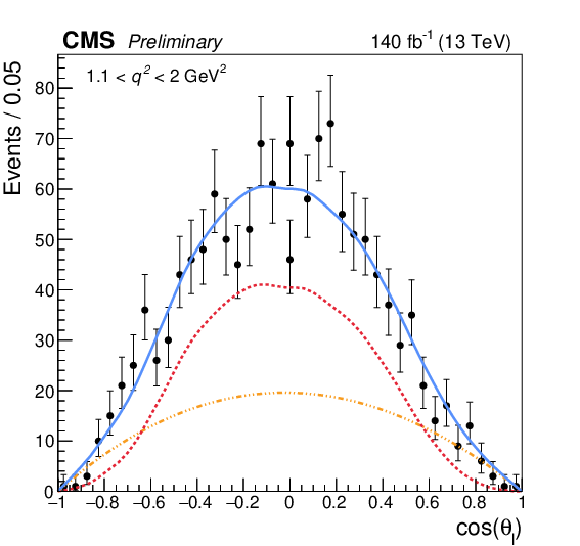
png pdf |
Additional Figure 1-c:
Mass and angular distributions for 1.1 <q2< 2 GeV2. The projections of the total fitted distribution (in blue) and its different components are overlaid. The signal is shown by the red dashed line, and the background by the orange line. |

png pdf |
Additional Figure 1-d:
Mass and angular distributions for 1.1 <q2< 2 GeV2. The projections of the total fitted distribution (in blue) and its different components are overlaid. The signal is shown by the red dashed line, and the background by the orange line. |
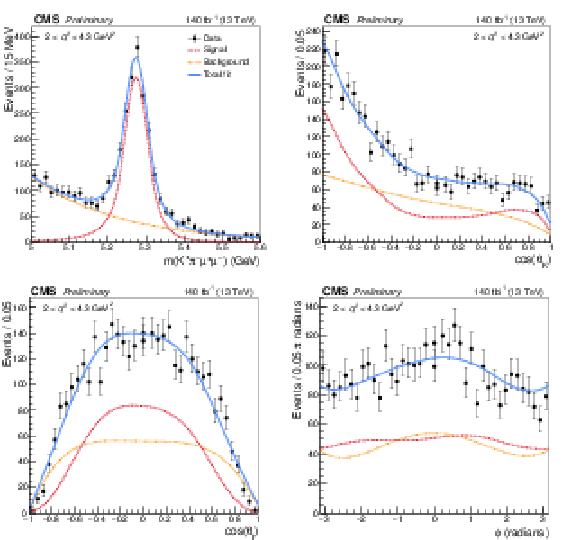
png pdf |
Additional Figure 2:
Mass and angular distributions for 2 <q2< 4.3 GeV2. The projections of the total fitted distribution (in blue) and its different components are overlaid. The signal is shown by the red dashed line, and the background by the orange line. |
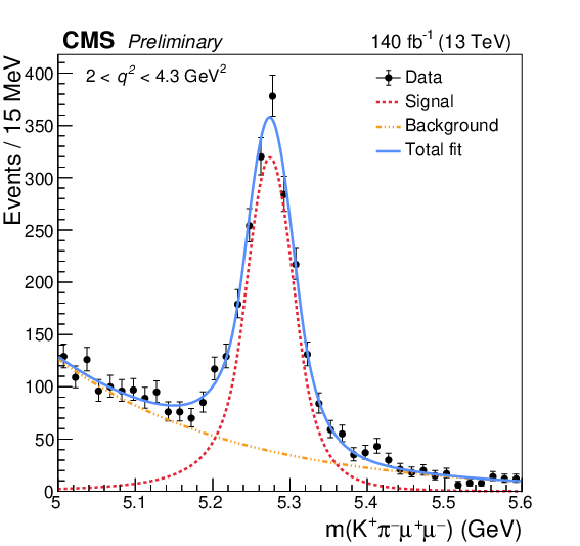
png pdf |
Additional Figure 2-a:
Mass and angular distributions for 2 <q2< 4.3 GeV2. The projections of the total fitted distribution (in blue) and its different components are overlaid. The signal is shown by the red dashed line, and the background by the orange line. |
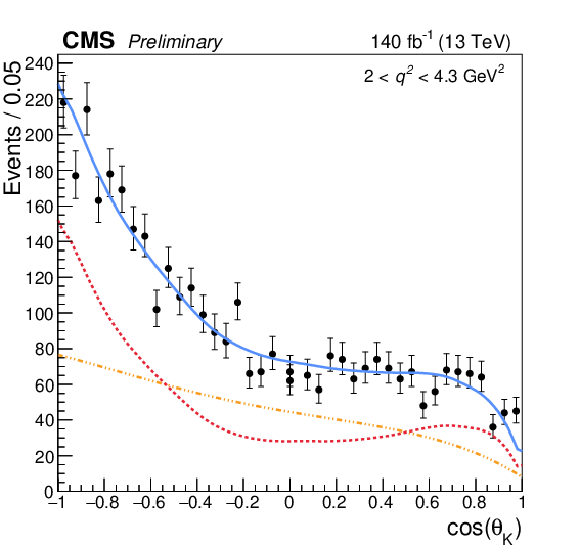
png pdf |
Additional Figure 2-b:
Mass and angular distributions for 2 <q2< 4.3 GeV2. The projections of the total fitted distribution (in blue) and its different components are overlaid. The signal is shown by the red dashed line, and the background by the orange line. |
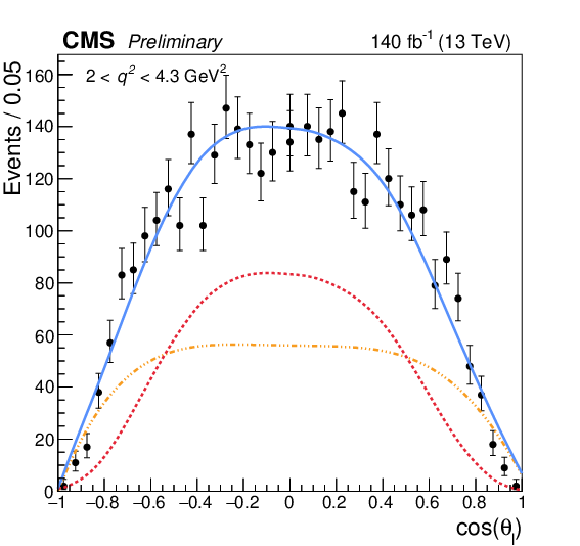
png pdf |
Additional Figure 2-c:
Mass and angular distributions for 2 <q2< 4.3 GeV2. The projections of the total fitted distribution (in blue) and its different components are overlaid. The signal is shown by the red dashed line, and the background by the orange line. |
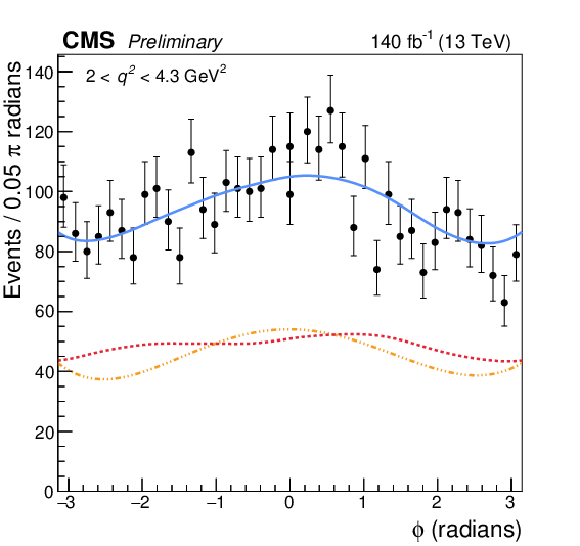
png pdf |
Additional Figure 2-d:
Mass and angular distributions for 2 <q2< 4.3 GeV2. The projections of the total fitted distribution (in blue) and its different components are overlaid. The signal is shown by the red dashed line, and the background by the orange line. |
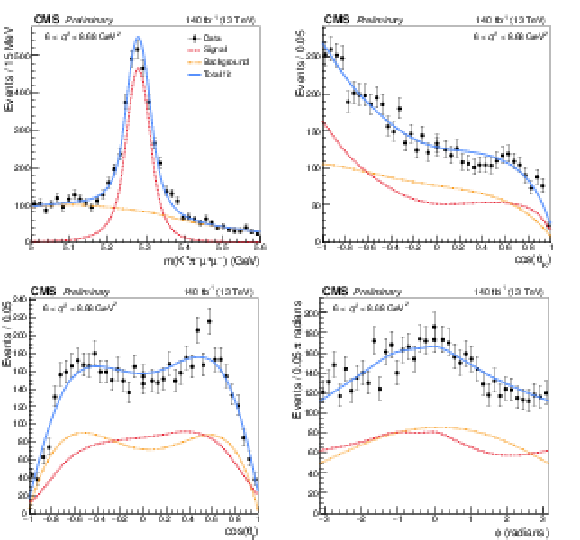
png pdf |
Additional Figure 3:
Mass and angular distributions for 6 <q2< 8.68 GeV2. The projections of the total fitted distribution (in blue) and its different components are overlaid. The signal is shown by the red dashed line, and the background by the orange line. |
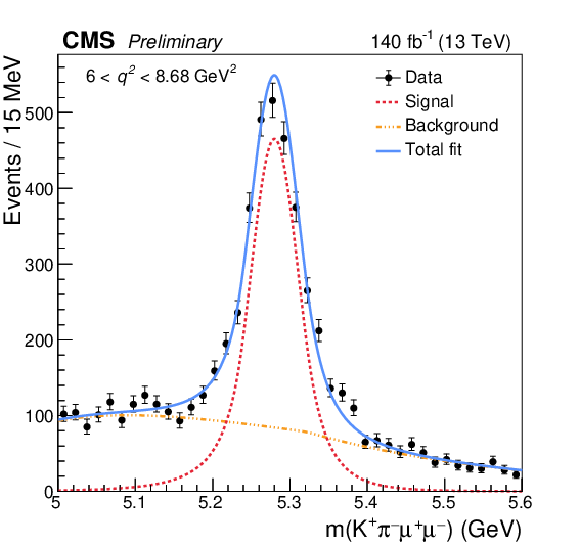
png pdf |
Additional Figure 3-a:
Mass and angular distributions for 6 <q2< 8.68 GeV2. The projections of the total fitted distribution (in blue) and its different components are overlaid. The signal is shown by the red dashed line, and the background by the orange line. |
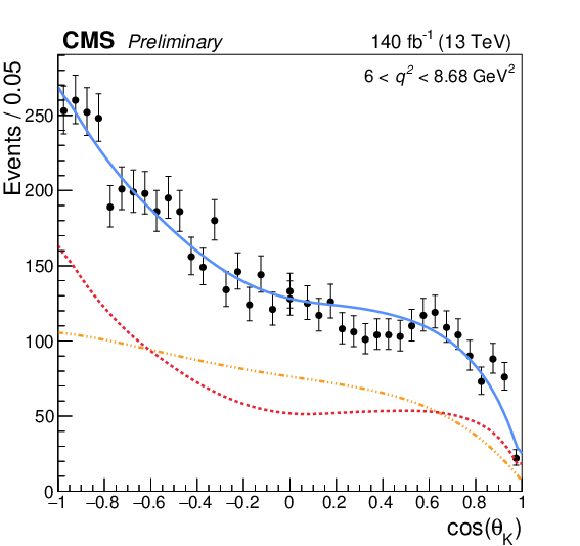
png pdf |
Additional Figure 3-b:
Mass and angular distributions for 6 <q2< 8.68 GeV2. The projections of the total fitted distribution (in blue) and its different components are overlaid. The signal is shown by the red dashed line, and the background by the orange line. |

png pdf |
Additional Figure 3-c:
Mass and angular distributions for 6 <q2< 8.68 GeV2. The projections of the total fitted distribution (in blue) and its different components are overlaid. The signal is shown by the red dashed line, and the background by the orange line. |
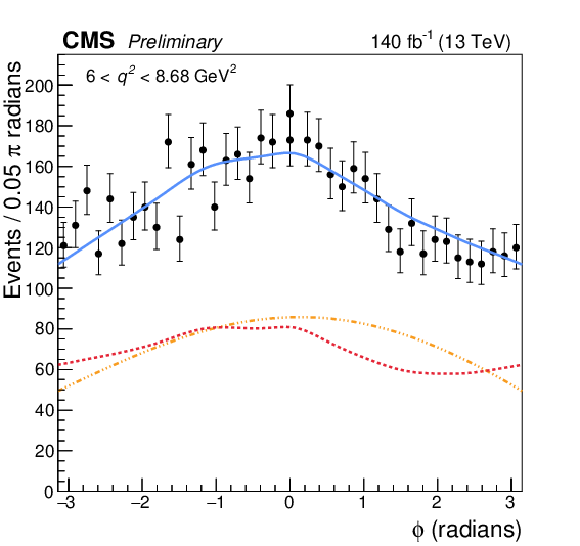
png pdf |
Additional Figure 3-d:
Mass and angular distributions for 6 <q2< 8.68 GeV2. The projections of the total fitted distribution (in blue) and its different components are overlaid. The signal is shown by the red dashed line, and the background by the orange line. |

png pdf |
Additional Figure 4:
Mass and angular distributions for 10.09 <q2< 12.86 GeV2. The projections of the total fitted distribution (in blue) and its different components are overlaid. The signal is shown by the red dashed line, and the background by the orange line. |
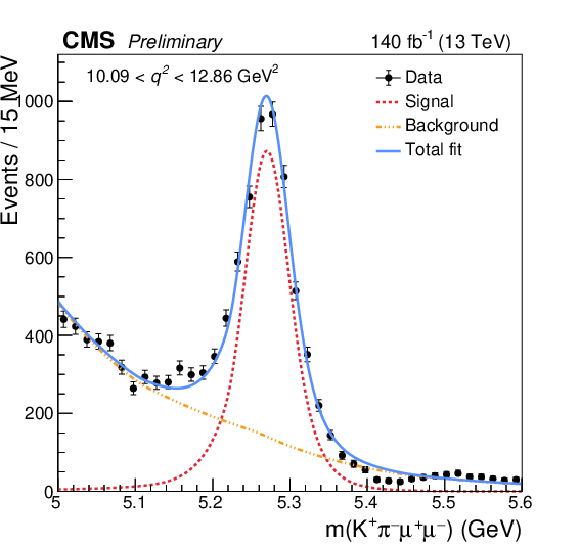
png pdf |
Additional Figure 4-a:
Mass and angular distributions for 10.09 <q2< 12.86 GeV2. The projections of the total fitted distribution (in blue) and its different components are overlaid. The signal is shown by the red dashed line, and the background by the orange line. |
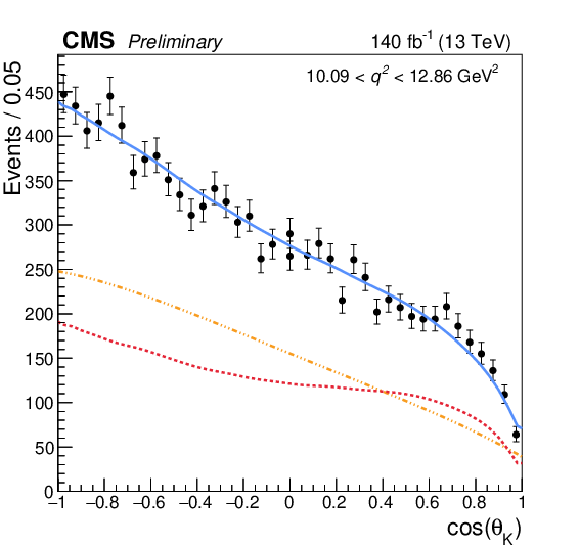
png pdf |
Additional Figure 4-b:
Mass and angular distributions for 10.09 <q2< 12.86 GeV2. The projections of the total fitted distribution (in blue) and its different components are overlaid. The signal is shown by the red dashed line, and the background by the orange line. |
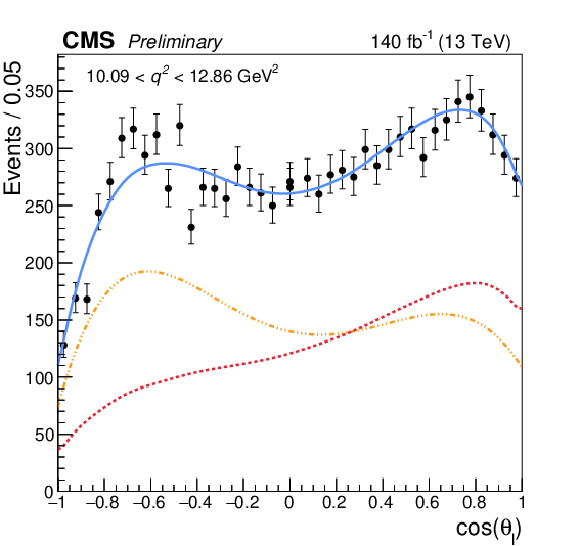
png pdf |
Additional Figure 4-c:
Mass and angular distributions for 10.09 <q2< 12.86 GeV2. The projections of the total fitted distribution (in blue) and its different components are overlaid. The signal is shown by the red dashed line, and the background by the orange line. |

png pdf |
Additional Figure 4-d:
Mass and angular distributions for 10.09 <q2< 12.86 GeV2. The projections of the total fitted distribution (in blue) and its different components are overlaid. The signal is shown by the red dashed line, and the background by the orange line. |
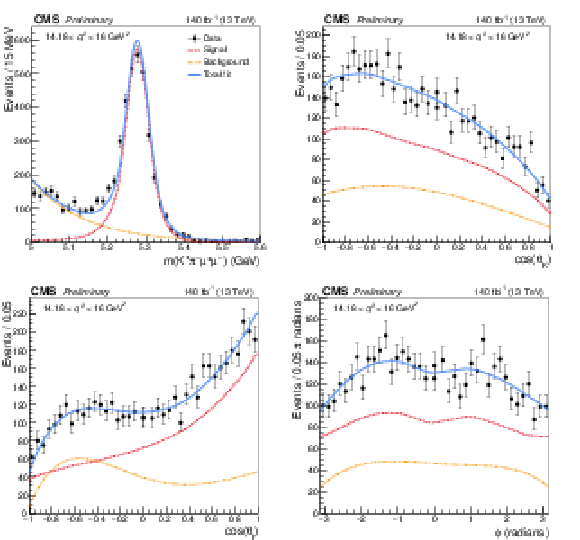
png pdf |
Additional Figure 5:
Mass and angular distributions for 14.18 <q2< 16 GeV2. The projections of the total fitted distribution (in blue) and its different components are overlaid. The signal is shown by the red dashed line, and the background by the orange line. |
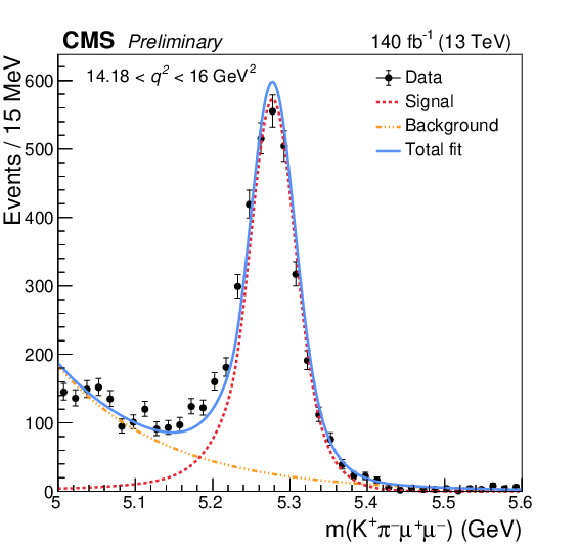
png pdf |
Additional Figure 5-a:
Mass and angular distributions for 14.18 <q2< 16 GeV2. The projections of the total fitted distribution (in blue) and its different components are overlaid. The signal is shown by the red dashed line, and the background by the orange line. |

png pdf |
Additional Figure 5-b:
Mass and angular distributions for 14.18 <q2< 16 GeV2. The projections of the total fitted distribution (in blue) and its different components are overlaid. The signal is shown by the red dashed line, and the background by the orange line. |
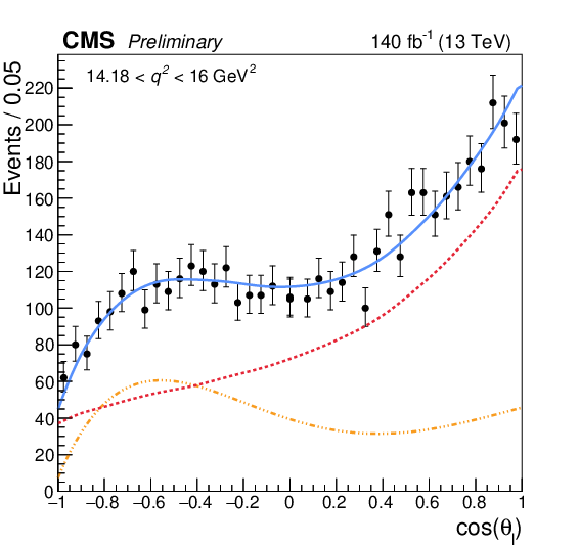
png pdf |
Additional Figure 5-c:
Mass and angular distributions for 14.18 <q2< 16 GeV2. The projections of the total fitted distribution (in blue) and its different components are overlaid. The signal is shown by the red dashed line, and the background by the orange line. |
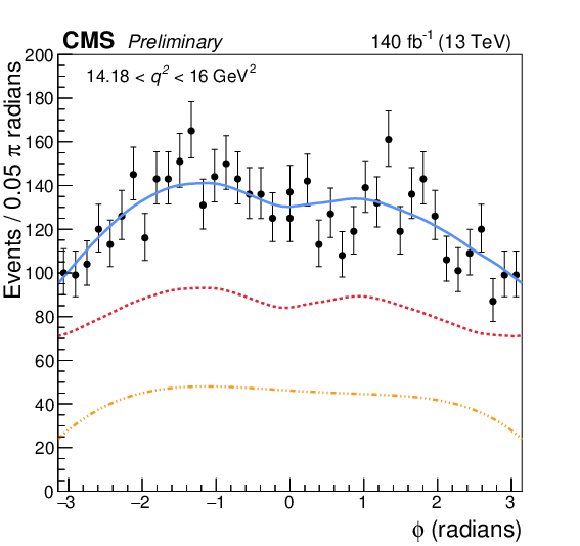
png pdf |
Additional Figure 5-d:
Mass and angular distributions for 14.18 <q2< 16 GeV2. The projections of the total fitted distribution (in blue) and its different components are overlaid. The signal is shown by the red dashed line, and the background by the orange line. |
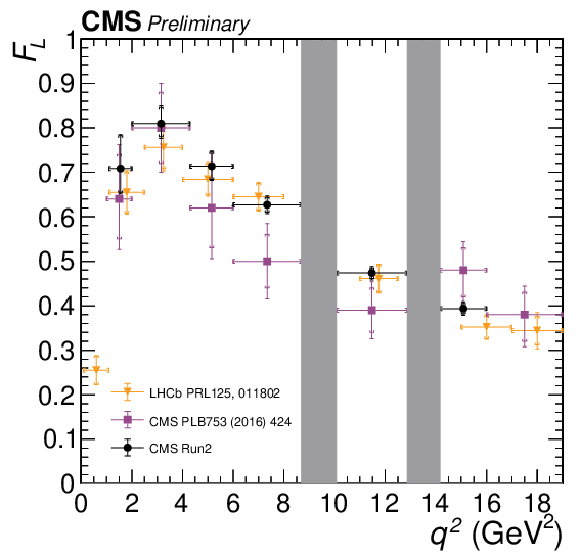
png pdf |
Additional Figure 6:
Measurements of the angular observable FL versus q2, in comparison to results from LHCb [12] and previous CMS publication [9]. The inner vertical bars represent the statistical uncertainties, while the outer vertical bars give the total uncertainties. The horizontal bars show the bin widths. The vertical shaded regions correspond to the J/ψ and ψ(2S) resonances. The definition of the q2 bins may differ between the various measurements. |
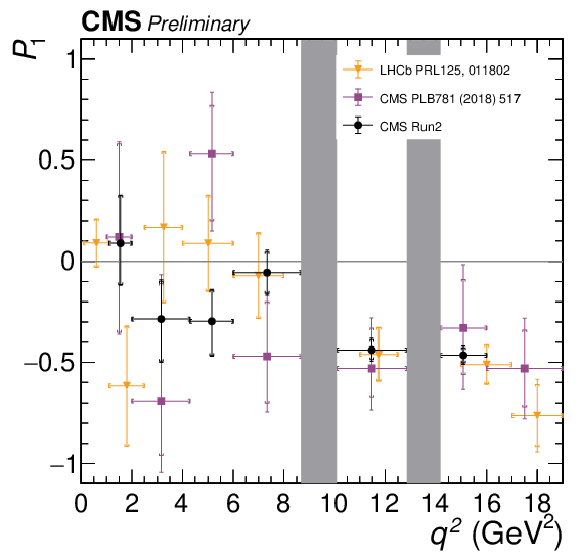
png pdf |
Additional Figure 7:
Measurements of the angular observable P1 versus q2, in comparison to results from LHCb [12] and previous CMS publication [10]. The inner vertical bars represent the statistical uncertainties, while the outer vertical bars give the total uncertainties. The horizontal bars show the bin widths. The vertical shaded regions correspond to the J/ψ and ψ(2S) resonances. The definition of the q2 bins may differ between the various measurements. |
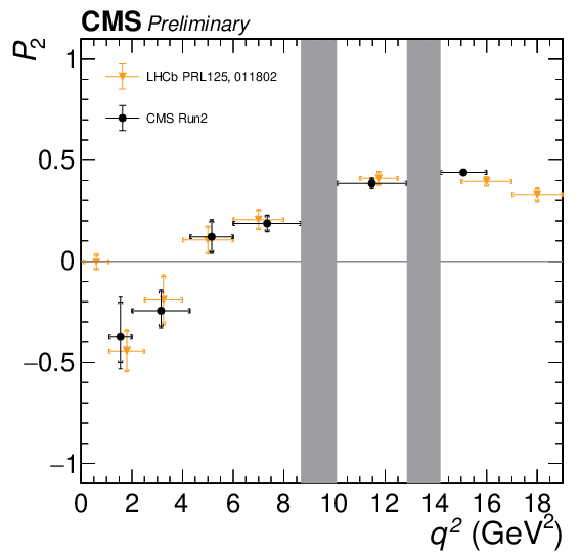
png pdf |
Additional Figure 8:
Measurements of the angular observable P2 versus q2, in comparison to results from LHCb [12]. The inner vertical bars represent the statistical uncertainties, while the outer vertical bars give the total uncertainties. The horizontal bars show the bin widths. The vertical shaded regions correspond to the J/ψ and ψ(2S) resonances. The definition of the q2 bins may differ between the various measurements. |
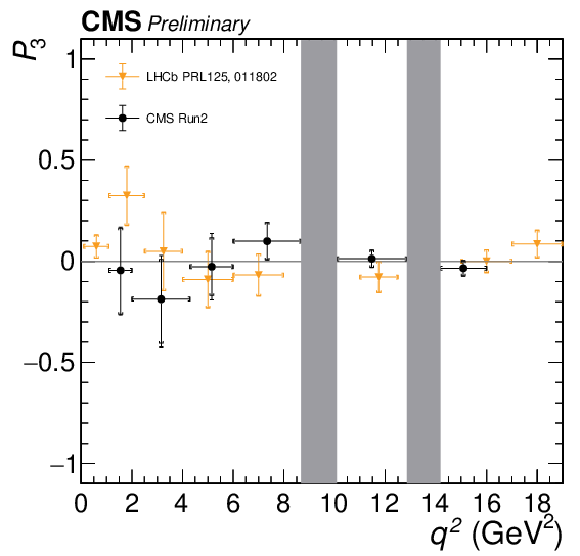
png pdf |
Additional Figure 9:
Measurements of the angular observable P3 versus q2, in comparison to results from LHCb [12]. The inner vertical bars represent the statistical uncertainties, while the outer vertical bars give the total uncertainties. The horizontal bars show the bin widths. The vertical shaded regions correspond to the J/ψ and ψ(2S) resonances. The definition of the q2 bins may differ between the various measurements. |
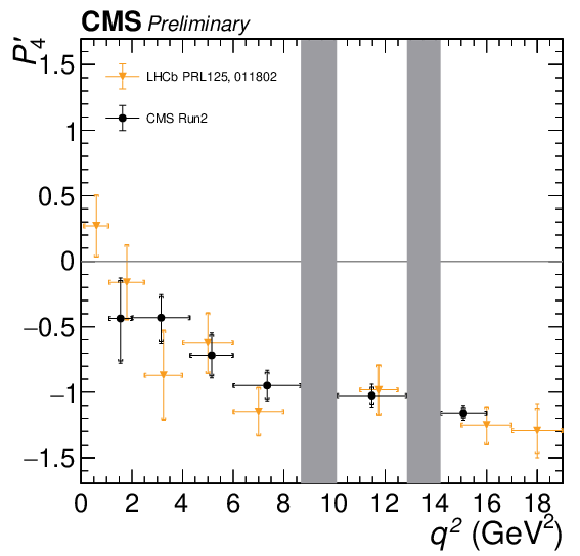
png pdf |
Additional Figure 10:
Measurements of the angular observable P′4 versus q2, in comparison to results from LHCb [12]. The inner vertical bars represent the statistical uncertainties, while the outer vertical bars give the total uncertainties. The horizontal bars show the bin widths. The vertical shaded regions correspond to the J/ψ and ψ(2S) resonances. The definition of the P′4 observable is the one presented in [16]: the results from the LHCb Collaboration are therefore appropriately scaled by a factor of two to superimpose them on the same plot. The definition of the q2 bins may differ between the various measurements. |
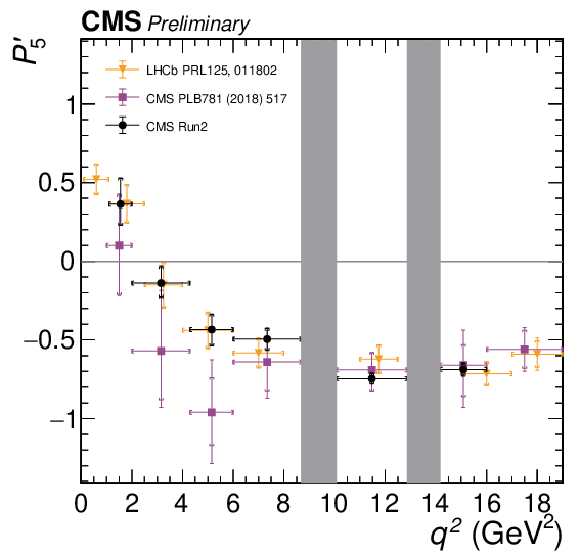
png pdf |
Additional Figure 11:
Measurements of the angular observable P′5 versus q2, in comparison to results from LHCb [12] and previous CMS publications [10]. The inner vertical bars represent the statistical uncertainties, while the outer vertical bars give the total uncertainties. The horizontal bars show the bin widths. The vertical shaded regions correspond to the J/ψ and ψ(2S) resonances. The definition of the q2 bins may differ between the various measurements. |
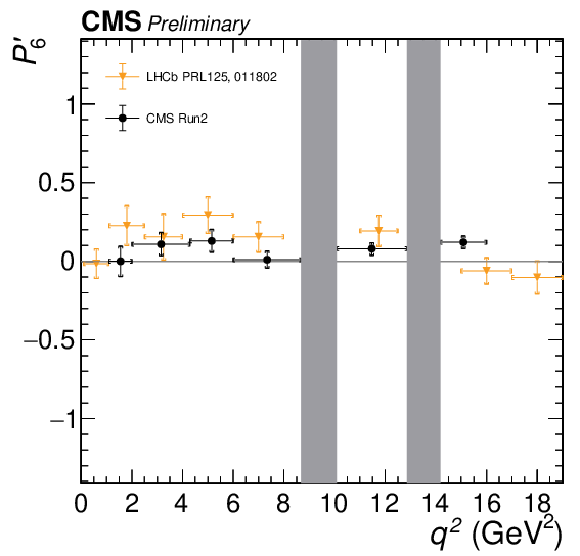
png pdf |
Additional Figure 12:
Measurements of the angular observable P′6 versus q2, in comparison to results from LHCb [12]. The inner vertical bars represent the statistical uncertainties, while the outer vertical bars give the total uncertainties. The horizontal bars show the bin widths. The vertical shaded regions correspond to the J/ψ and ψ(2S) resonances. The definition of the P′6 observable is the one presented in [16]: the results from the LHCb Collaboration are therefore appropriately scaled by a factor of minus one to superimpose them on the same plot. The definition of the q2 bins may differ between the various measurements. |
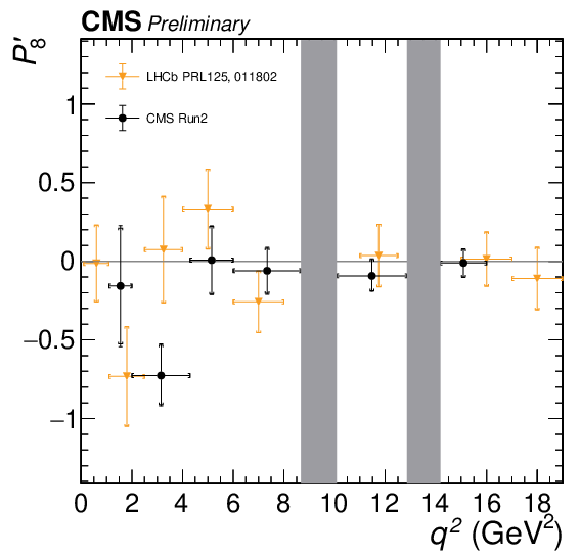
png pdf |
Additional Figure 13:
Measurements of the angular observable P′8 versus q2, in comparison to results from LHCb [12]. The inner vertical bars represent the statistical uncertainties, while the outer vertical bars give the total uncertainties. The horizontal bars show the bin widths. The vertical shaded regions correspond to the J/ψ and ψ(2S) resonances. The definition of the P′8 observable is the one presented in [16]: the results from the LHCb Collaboration are therefore appropriately scaled by a factor of two to superimpose them on the same plot. The definition of the q2 bins may differ between the various measurements. |
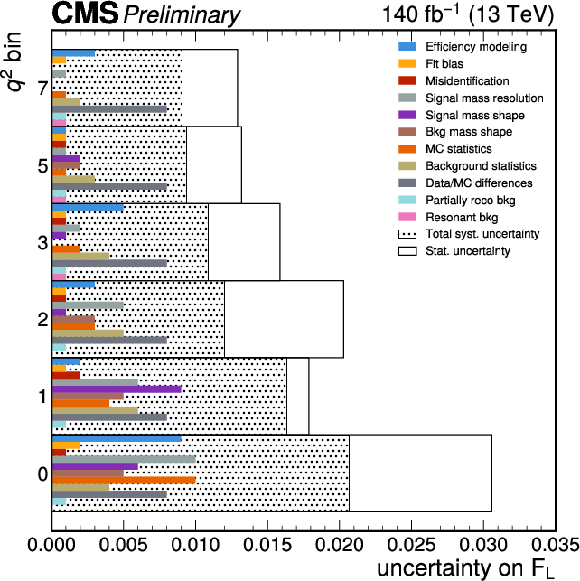
png pdf |
Additional Figure 14:
The various sources of systematic uncertainty per each q2 bin, for the FL observable. The total systematic uncertainty and the statistical uncertainty are shown by the dotted area and white bar, respectively. The vertical axis represents the index of the q2 bins used in the analysis, ordered with increasing q2 value and excluding the bins dominated by the resonant channels. |

png pdf |
Additional Figure 15:
The various sources of systematic uncertainty per each q2 bin, for the P1 observable. The total systematic uncertainty and the statistical uncertainty are shown by the dotted area and white bar, respectively. The vertical axis represents the index of the q2 bins used in the analysis, ordered with increasing q2 value and excluding the bins dominated by the resonant channels. |
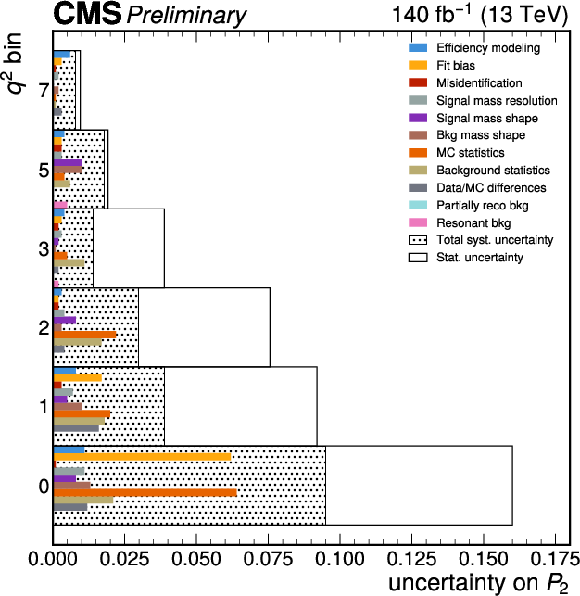
png pdf |
Additional Figure 16:
The various sources of systematic uncertainty per each q2 bin, for the P2 observable. The total systematic uncertainty and the statistical uncertainty are shown by the dotted area and white bar, respectively. The vertical axis represents the index of the q2 bins used in the analysis, ordered with increasing q2 value and excluding the bins dominated by the resonant channels. |

png pdf |
Additional Figure 17:
The various sources of systematic uncertainty per each q2 bin, for the P3 observable. The total systematic uncertainty and the statistical uncertainty are shown by the dotted area and white bar, respectively. The vertical axis represents the index of the q2 bins used in the analysis, ordered with increasing q2 value and excluding the bins dominated by the resonant channels. |
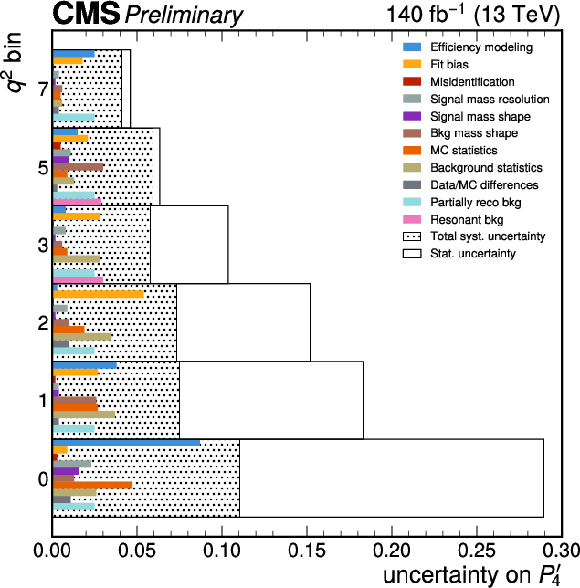
png pdf |
Additional Figure 18:
The various sources of systematic uncertainty per each q2 bin, for the P′4 observable. The total systematic uncertainty and the statistical uncertainty are shown by the dotted area and white bar, respectively. The vertical axis represents the index of the q2 bins used in the analysis, ordered with increasing q2 value and excluding the bins dominated by the resonant channels. |
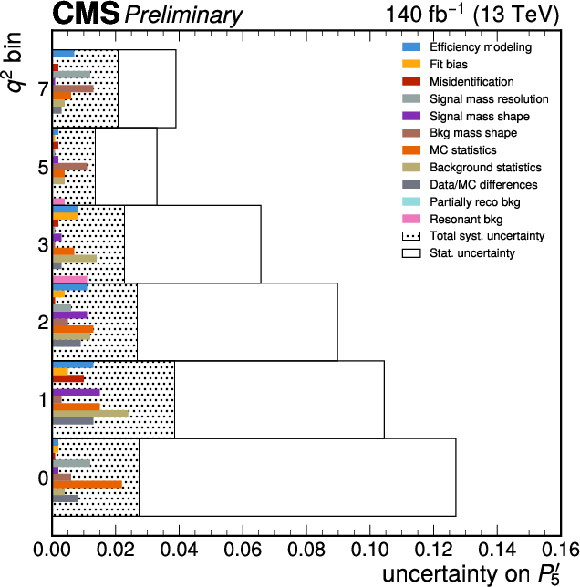
png pdf |
Additional Figure 19:
The various sources of systematic uncertainty per each q2 bin, for the P′5 observable. The total systematic uncertainty and the statistical uncertainty are shown by the dotted area and white bar, respectively. The vertical axis represents the index of the q2 bins used in the analysis, ordered with increasing q2 value and excluding the bins dominated by the resonant channels. |
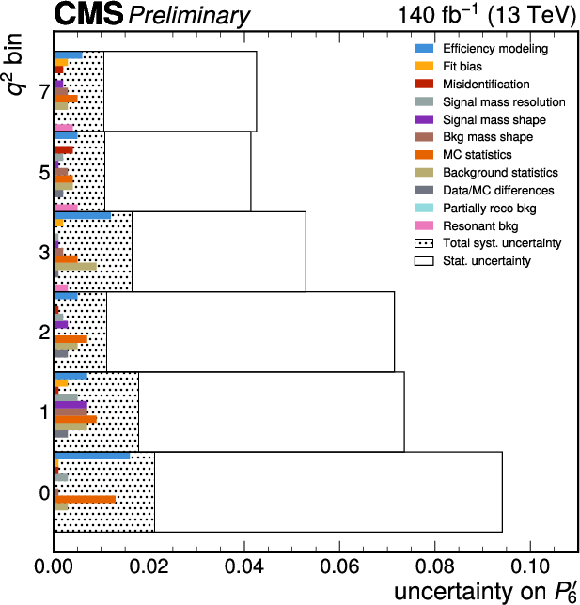
png pdf |
Additional Figure 20:
The various sources of systematic uncertainty per each q2 bin, for the P′6 observable. The total systematic uncertainty and the statistical uncertainty are shown by the dotted area and white bar, respectively. The vertical axis represents the index of the q2 bins used in the analysis, ordered with increasing q2 value and excluding the bins dominated by the resonant channels. |
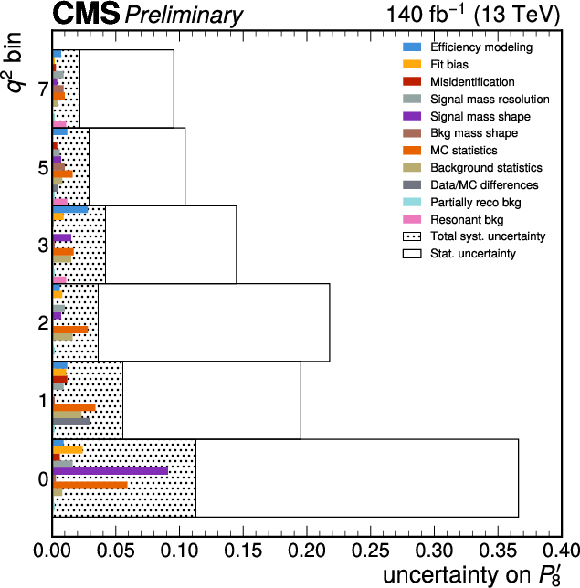
png pdf |
Additional Figure 21:
The various sources of systematic uncertainty per each q2 bin, for the P′8 observable. The total systematic uncertainty and the statistical uncertainty are shown by the dotted area and white bar, respectively. The vertical axis represents the index of the q2 bins used in the analysis, ordered with increasing q2 value and excluding the bins dominated by the resonant channels. |
| Additional Tables | |
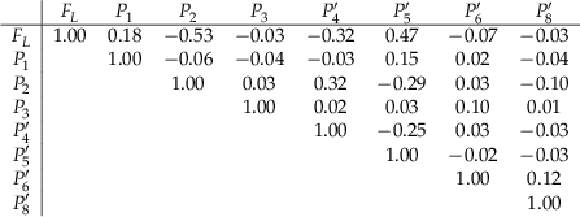
png pdf |
Additional Table 1:
Correlation matrix of the statistical uncertainties of the angular observables, from the maximum-likelihood fit in the region 1.1 <q2< 2 GeV2. |
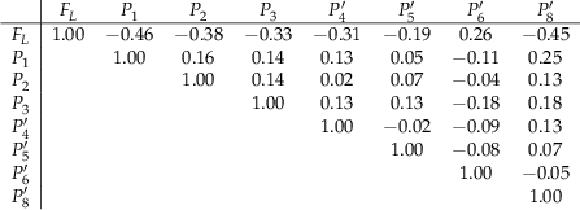
png pdf |
Additional Table 2:
Correlation matrix of the statistical uncertainties of the angular observables, from the maximum-likelihood fit in the region 2 <q2< 4.3 GeV2. |
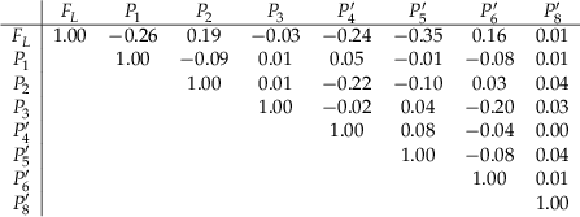
png pdf |
Additional Table 3:
Correlation matrix of the statistical uncertainties of the angular observables, from the maximum-likelihood fit in the region 4.3 <q2< 6 GeV2. |

png pdf |
Additional Table 4:
Correlation matrix of the statistical uncertainties of the angular observables, from the maximum-likelihood fit in the region 6 <q2< 8.68 GeV2. |
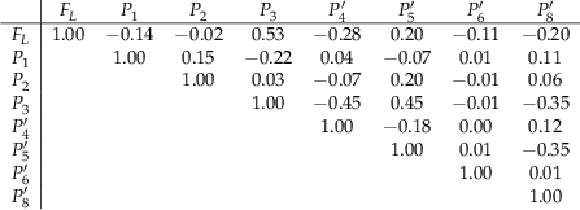
png pdf |
Additional Table 5:
Correlation matrix of the statistical uncertainties of the angular observables, from the maximum-likelihood fit in the region 10.09 <q2< 12.86 GeV2. |
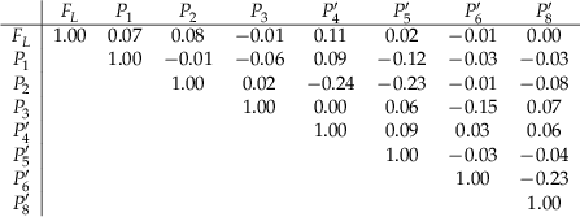
png pdf |
Additional Table 6:
Correlation matrix of the statistical uncertainties of the angular observables, from the maximum-likelihood fit in the region 14.18 <q2< 16 GeV2. |
| References | ||||
| 1 | CDF Collaboration | Measurements of the Angular Distributions in the Decays B→K(∗)μ+μ− at CDF | PRL 108 (2012) 081807 | 1108.0695 |
| 2 | BaBar Collaboration | Angular Distributions in the Decays B ---\ensuremath> K* l+ l- | PRD 79 (2009) 031102 | 0804.4412 |
| 3 | Belle Collaboration | Measurement of the Differential Branching Fraction and Forward-Backward Asymmetry for B→K(∗)ℓ+ℓ− | PRL 103 (2009) 171801 | 0904.0770 |
| 4 | Belle Collaboration | Lepton-Flavor-Dependent Angular Analysis of B→K∗ℓ+ℓ− | PRL 118 (2017) 111801 | 1612.05014 |
| 5 | LHCb Collaboration | Differential branching fraction and angular analysis of the decay B0→K∗0μ+μ− | JHEP 08 (2013) 131 | 1304.6325 |
| 6 | LHCb Collaboration | Measurement of Form-Factor-Independent Observables in the Decay B0→K∗0μ+μ− | PRL 111 (2013) 191801 | 1308.1707 |
| 7 | LHCb Collaboration | Angular analysis of the B0→K∗0μ+μ− decay using 3 fb−1 of integrated luminosity | JHEP 02 (2016) 104 | 1512.04442 |
| 8 | CMS Collaboration | Angular Analysis and Branching Fraction Measurement of the Decay B0→K∗0μ+μ− | PLB 727 (2013) 77 | CMS-BPH-11-009 1308.3409 |
| 9 | CMS Collaboration | Angular analysis of the decay B0→K∗0μ+μ− from pp collisions at √s= 8 TeV | PLB 753 (2016) 424 | CMS-BPH-13-010 1507.08126 |
| 10 | CMS Collaboration | Measurement of angular parameters from the decay B0→K∗0μ+μ− in proton-proton collisions at √s= 8 TeV | PLB 781 (2018) 517 | CMS-BPH-15-008 1710.02846 |
| 11 | ATLAS Collaboration | Angular analysis of B0d→K∗μ+μ− decays in pp collisions at √s= 8 TeV with the ATLAS detector | JHEP 10 (2018) 047 | 1805.04000 |
| 12 | LHCb Collaboration | Measurement of CP-Averaged Observables in the B0→K∗0μ+μ− Decay | PRL 125 (2020) 011802 | 2003.04831 |
| 13 | M. Ciuchini et al. | Charming penguins and lepton universality violation in b→sℓ+ℓ− decays | EPJC 83 (2023) 64 | 2110.10126 |
| 14 | F. Kruger and J. Matias | Probing new physics via the transverse amplitudes of B0→K∗0(→K−π+)l+l− at large recoil | PRD 71 (2005) 094009 | hep-ph/0502060 |
| 15 | W. Altmannshofer et al. | Symmetries and Asymmetries of B→K∗μ+μ− Decays in the Standard Model and Beyond | JHEP 01 (2009) 019 | 0811.1214 |
| 16 | S. Descotes-Genon, J. Matias, M. Ramon, and J. Virto | Implications from clean observables for the binned analysis of B−>K∗μ+μ− at large recoil | JHEP 01 (2013) 048 | 1207.2753 |
| 17 | CMS Collaboration | Performance of the CMS muon detector and muon reconstruction with proton-proton collisions at √s= 13 TeV | JINST 13 (2018) P06015 | CMS-MUO-16-001 1804.04528 |
| 18 | CMS Collaboration | Description and performance of track and primary-vertex reconstruction with the CMS tracker | JINST 9 (2014) P10009 | CMS-TRK-11-001 1405.6569 |
| 19 | CMS Tracker Group Collaboration | The CMS phase-1 pixel detector upgrade | JINST 16 (2021) P02027 | 2012.14304 |
| 20 | CMS Collaboration | Track impact parameter resolution for the full pseudo rapidity coverage in the 2017 dataset with the CMS phase-1 pixel detector | CMS Detector Performance Summary CMS-DP-2020-049, 2020 CDS |
|
| 21 | CMS Collaboration | The CMS experiment at the CERN LHC | JINST 3 (2008) S08004 | |
| 22 | CMS Collaboration | Performance of the CMS Level-1 trigger in proton-proton collisions at √s= 13\,TeV | JINST 15 (2020) P10017 | CMS-TRG-17-001 2006.10165 |
| 23 | CMS Collaboration | The CMS trigger system | JINST 12 (2017) P01020 | CMS-TRG-12-001 1609.02366 |
| 24 | T. Sjöstrand et al. | An introduction to PYTHIA 8.2 | Comput. Phys. Commun. 191 (2015) 159 | 1410.3012 |
| 25 | D. J. Lange | The EvtGen particle decay simulation package | NIM A 462 (2001) 152 | |
| 26 | E. Barberio, B. van Eijk, and Z. W \c a s | PHOTOS --- a universal Monte Carlo for QED radiative corrections in decays | Comput. Phys. Commun. 66 (1991) 115 | |
| 27 | E. Barberio and Z. W \c a s | PHOTOS -- a universal Monte Carlo for QED radiative corrections: version 2.0 | Comput. Phys. Commun. 79 (1994) 291 | |
| 28 | GEANT4 Collaboration | GEANT 4---a simulation toolkit | NIM A 506 (2003) 250 | |
| 29 | Particle Data Group Collaboration | Review of Particle Physics | PTEP 2022 (2022) 083C01 | |
| 30 | M. Pivk and F. Le Diberder | Plots: A statistical tool to unfold data distributions | NIMA 555 (2005) 356 | |
| 31 | CMS Collaboration | Precise determination of the mass of the Higgs boson and tests of compatibility of its couplings with the standard model predictions using proton collisions at 7 and 8 TeV | EPJC 75 (2015) 212 | CMS-HIG-14-009 1412.8662 |
| 32 | F. Beaujean, M. Chrzaszcz, N. Serra, and D. van Dyk | Extracting angular observables without a likelihood and applications to rare decays | PRD 91 (2011) 114012 | |
| 33 | D. M. Straub | flavio: a python package for flavour and precision phenomenology in the standard model and beyond | link | 1810.08132 |
| 34 | D. van Dyk et al. | Eos version 1.0.10 | 2023 link |
|
| 35 | R. R. Horgan, Z. Liu, S. Meinel, and M. Wingate | Lattice QCD calculation of form factors describing the rare decays B→K∗ℓ+ℓ− and Bs→ϕℓ+ℓ− | PRD 8 (1900) 9 | 1310.3722 |
| 36 | R. R. Horgan, Z. Liu, S. Meinel, and M. Wingate | Rare B decays using lattice QCD form factors | PoS LATTICE 372, 2015 link |
1501.00367 |
| 37 | A. Bharucha, D. M. Straub, and R. Zwicky | B→Vℓ+ℓ− in the Standard Model from light-cone sum rules | JHEP 08 (2016) 098 | 1503.05534 |
| 38 | M. Beneke, T. Feldmann, and D. Seidel | Exclusive radiative and electroweak b→d and b→s penguin decays at NLO | EPJC 41 (2005) 173 | hep-ph/0412400 |
| 39 | M. Beneke, T. Feldmann, and D. Seidel | Systematic approach to exclusive B→Vl+l−, Vγ decays | NPB 612 (2001) 25 | hep-ph/0106067 |
| 40 | N. Gubernari, M. Reboud, D. van Dyk, and J. Virto | Improved theory predictions and global analysis of exclusive b→sμ+μ− processes | JHEP 09 (2022) 133 | 2206.03797 |
| 41 | N. Gubernari, A. Kokulu, and D. van Dyk | B→P and B→V Form Factors from B-Meson Light-Cone Sum Rules beyond Leading Twist | JHEP 01 (2019) 150 | 1811.00983 |

|
Compact Muon Solenoid LHC, CERN |

|

|

|

|

|

|